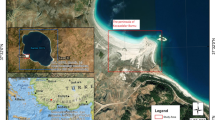Abstract
It is necessary to estimate heavy metal concentrations within soils for understanding heavy metal contaminations and for keeping the sustainable developments of ecosystems. This study, with the floodplain along Le’an River and its two branches in Jiangxi Province of China as a case study, aimed to explore the feasibility of estimating concentrations of heavy metal lead (Pb), copper (Cu) and zinc (Zn) within soils using laboratory-based hyperspectral data. Thirty soil samples were collected, and their hyperspectral data, soil organic matters and Pb, Cu and Zn concentrations were measured in the laboratory. The potential relations among hyperspectral data, soil organic matter and Pb, Cu and Zn concentrations were explored and further used to estimate Pb, Cu and Zn concentrations from hyperspectral data with soil organic matter as a bridge. The results showed that the ratio of the first-order derivatives of spectral absorbance at wavelengths 624 and 564 nm could explain 52% of the variation of soil organic matter; the soil organic matter could explain 59%, 51% and 50% of the variation of Pb, Cu and Zn concentrations with estimated standard errors of 1.41, 48.27 and 45.15 mg·kg−; and the absolute estimation errors were 8%–56%, 12%–118% and 2%–22%, and 50%, 67% and 100% of them were less than 25% for Pb, Cu and Zn concentration estimations. We concluded that the laboratory-based hyperspectral data hold potentials in estimating concentrations of heavy metal Pb, Cu and Zn in soils. More sampling points or other potential linear and non-linear regression methods should be used for improving the stabilities and accuracies of the estimation models.
Similar content being viewed by others
References
Wild A (1993) Soils and the environment: an introduction [M]. New York: Cambridge University Press
Alloway B J (1994) Heavy metals in soils [M]. Berlin: Springer
Kishe M A, Machiwa J F (2003) Distribution of heavy metals in sediments of Mwanza Gulf of Lake Victoria, Tanzania[J]. Environment International, 28(7): 619–625
Ozmen H, Kulahci F, Cukurovali A, et al. (2004) Concentrations of heavy metal and radioactivity in surface water and sediment of Hazar Lake (Elazig, Turkey)[J]. Chemosphere, 55(3): 401–408
UNESCO (1996) Ecological effects of heavy-metal pollution in the Dexing copper mine region (Jian Xi province, China)[R]. The United nations Educational, Scientific and Cultural Organization.
Clevers, Kooistra, Salas (2004) Study of heavy metal contamination in river floodplains using the red-edge position in spectroscopic data[J]. International Journal of Remote Sensing, 25(19): 3883–3895
Dauvalter V, Rognerud S (2001) Heavy metal pollution in sediments of the Pasvik River drainage[J]. Chemosphere, 42(1): 9–18
Kemper T, Sommer S (2002) Estimate of heavy metal contamination in soils after a mining accident using reflectance spectroscopy[J]. Environmental Science & Technology, 36(12): 2742–2747
Choe E, van der Meer F, van Ruitenbeek F, et al. (2008) Mapping of heavy metal pollution in stream sediments using combined geochemistry, field spectroscopy, and hyperspectral remote sensing: a case study of the Rodalquilar mining area, SE Spain[J]. Remote Sensing of Environment, 112(7): 3222–3233
Demattê J A M, Campos R C, Alves M C, et al. (2004) Visible-NIR reflectance: A new approach on soil evaluation[ J]. Geoderma, 121(1–2): 95–112
Kooistra L, Wanders J, Epema G F, et al. (2003) The potential of field spectroscopy for the assessment of sediment properties in river floodplains[J]. Analytica Chimica Acta, 484(2): 189–200
Melendez-Pastor I, Navarro-Pedreño J, Gómez I, et al. (2008) Identifying optimal spectral bands to assess soil properties with VNIR radiometry in semi-arid soils[J]. Geoderma, 147(3–4): 126–132
Kooistra L, Wehrens R, Leuven R S, et al. (2001) Possibilities of visible-near-infrared spectroscopy for the assessment of soil contamination in river floodplains[J]. Analytica Chimica Acta, 446(1–2): 97–105
Liu W X, Coveney R M, Chen J L (2003) Environmental quality assessment on a river system polluted by mining activities[J]. Applied Geochemistry, 18(5): 749–764
Zeng F, Xiao H, Zhou W (2007) Spatial and temporal variations and their source analysis of Copper, Lead and Zinc in river-waters and sediments of the Le’an River (in Chinese)[J]. Research of Environmental Sciences, 20(6): 14–20
He M, Wang Z, Tang H (1998) The chemical, toxicological and ecological studies in assessing the heavy metal pollution in Le An River, China[J]. Water Research, 32(2): 510–518
Walkley A L, Black A (1947) A critical examination of a rapid method for determination of organic carbon in soils-effect of variations in digestion conditions and of inorganic soil constituents[J].Soil Science, 63: 251–163
Krishnan P, Alexander J D, Butler B J, et al.(1980) Reflectance technique for predicting soil organic matter[J]. Soil Science, 44(6): 1282–1285
Efron B(1979) Bootstrap methods: another look at the Jackknife[J]. Annals of Statistics, 7(1): 1–26
Lu Y, Bai Y, Yang L, et al. (2007) Prediction and validation of soil organic matter content based on hyperspectrum (in Chinese) [J]. Scientia Agricultura Sinica, 40(9): 1989–1995
Wang J, Huang C P, Allen H E, et al. (1999) Effects of dissolved organic matter and pH on heavy metal uptake by sludge particulates exemplified by Copper (II) and Nickel (II): three-variable model [J]. Water Environment Research, 71: 139–147
Middelkoop H (1997) Embanked floodplains in the Netherlands: geomorphological evolution over various time scales [D]. Universiteit Utrecht
Author information
Authors and Affiliations
Corresponding author
Additional information
Supported by the National Natural Science Foundation of China (No. 40971191); the Scientific Research Starting Foundation of Ministry of Education of China for Returned Overseas Chinese Scholars; the Special Foundation of Ministry of Finance of China for Nonprofit Research of Forestry Industry (No. 200904001).
LIU Yaolin is a Professor of Wuhan University. He received his Ph.D. degree from Wageningen University, the Netherlands. His interests include geographical information system, remote sensing and land information system.
About this article
Cite this article
Liu, Y., Li, W., Wu, G. et al. Feasibility of estimating heavy metal contaminations in floodplain soils using laboratory-based hyperspectral data—A case study along Le’an River, China. Geo-spat. Inf. Sci. 14, 10–16 (2011). https://doi.org/10.1007/s11806-011-0424-0
Received:
Published:
Issue Date:
DOI: https://doi.org/10.1007/s11806-011-0424-0




